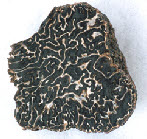
Truffles and mushrooms (Consulting) Limited
© Truffles and Mushrooms (Consulting) Ltd

Truffle cultivation in New Zealand
When Ian Hall learnt of the pioneering work on truffle cultivation carried out in France and Italy in the late 1970s he decided that it must be possible to do the same in the Southern Hemisphere and produce truffles out-of-season for Northern Hemisphere markets. The first hurdle was convincing directors that there was a market for truffles, a significant problem when the only mushrooms eaten in New Zealand were little white rubbery things that grew on supermarket shelves. The next step was determining the climatic conditions in those areas of France where the Périgord black truffle was found by superimposing climatic maps of France on a map of the distribution of the Périgord black truffle. Those areas in New Zealand with similar climatic conditions were then determined. Because New Zealand has a predominantly oceanic climate, summer temperatures are lower and winter temperatures higher than similar latitudes in France.
The second important consideration was the characteristics of soils where the Périgord black truffle grew naturally in Europe. This information was more difficult to obtain because the techniques used in French and Italian laboratories to measure nutrient concentrations in soils were rather different from those used in New Zealand. However, sufficient information was eventually collected to enable comparisons to be made.
The third and most important hurdle that had to be overcome was to source truffle infected plants. In the 1800s when porcini accidentally entered New Zealand, there were no controls on what could or could not be imported. However, the serious ecological problems caused by introducing animals such as rabbits and plants like gorse has resulted in ever tightening controls on the importation of exotic organisms into New Zealand. It was, therefore, impossible to import truffle infected plants from Europe because of the chance that these might carry serious plant pathogens. Consequently, Ian imported truffle from Europe and then developed his own methods from basic principles—needless to say French and Italian companies were not prepared to release confidential information on how they produced their truffle infected plants.
In 1987, within two years of beginning research, a few hundred Périgord black truffle infected plants were produced and used to establish two small truffières in North Otago at 45°S on rendzina soils with pH 7.8 – 8.1. Considerable publicity surrounded these first experiments and this generated a demand for Périgord black truffle infected plants by the general public and a small facility was set up to produce sufficient Périgord black truffle infected plants to meet market demand--about 3000 plants each year.
The second important consideration was the characteristics of soils where the Périgord black truffle grew naturally in Europe. This information was more difficult to obtain because the techniques used in French and Italian laboratories to measure nutrient concentrations in soils were rather different from those used in New Zealand. However, sufficient information was eventually collected to enable comparisons to be made.
The third and most important hurdle that had to be overcome was to source truffle infected plants. In the 1800s when porcini accidentally entered New Zealand, there were no controls on what could or could not be imported. However, the serious ecological problems caused by introducing animals such as rabbits and plants like gorse has resulted in ever tightening controls on the importation of exotic organisms into New Zealand. It was, therefore, impossible to import truffle infected plants from Europe because of the chance that these might carry serious plant pathogens. Consequently, Ian imported truffle from Europe and then developed his own methods from basic principles—needless to say French and Italian companies were not prepared to release confidential information on how they produced their truffle infected plants.
In 1987, within two years of beginning research, a few hundred Périgord black truffle infected plants were produced and used to establish two small truffières in North Otago at 45°S on rendzina soils with pH 7.8 – 8.1. Considerable publicity surrounded these first experiments and this generated a demand for Périgord black truffle infected plants by the general public and a small facility was set up to produce sufficient Périgord black truffle infected plants to meet market demand-


New Zealand’s first truffières established between 1987 and 1990. Areas in red are those that have produced Périgord black truffles.
RIGHT New Zealand superimposed on Europe. The black areas are those where the Périgord black truffle grows naturally in France and Italy.
RIGHT New Zealand superimposed on Europe. The black areas are those where the Périgord black truffle grows naturally in France and Italy.